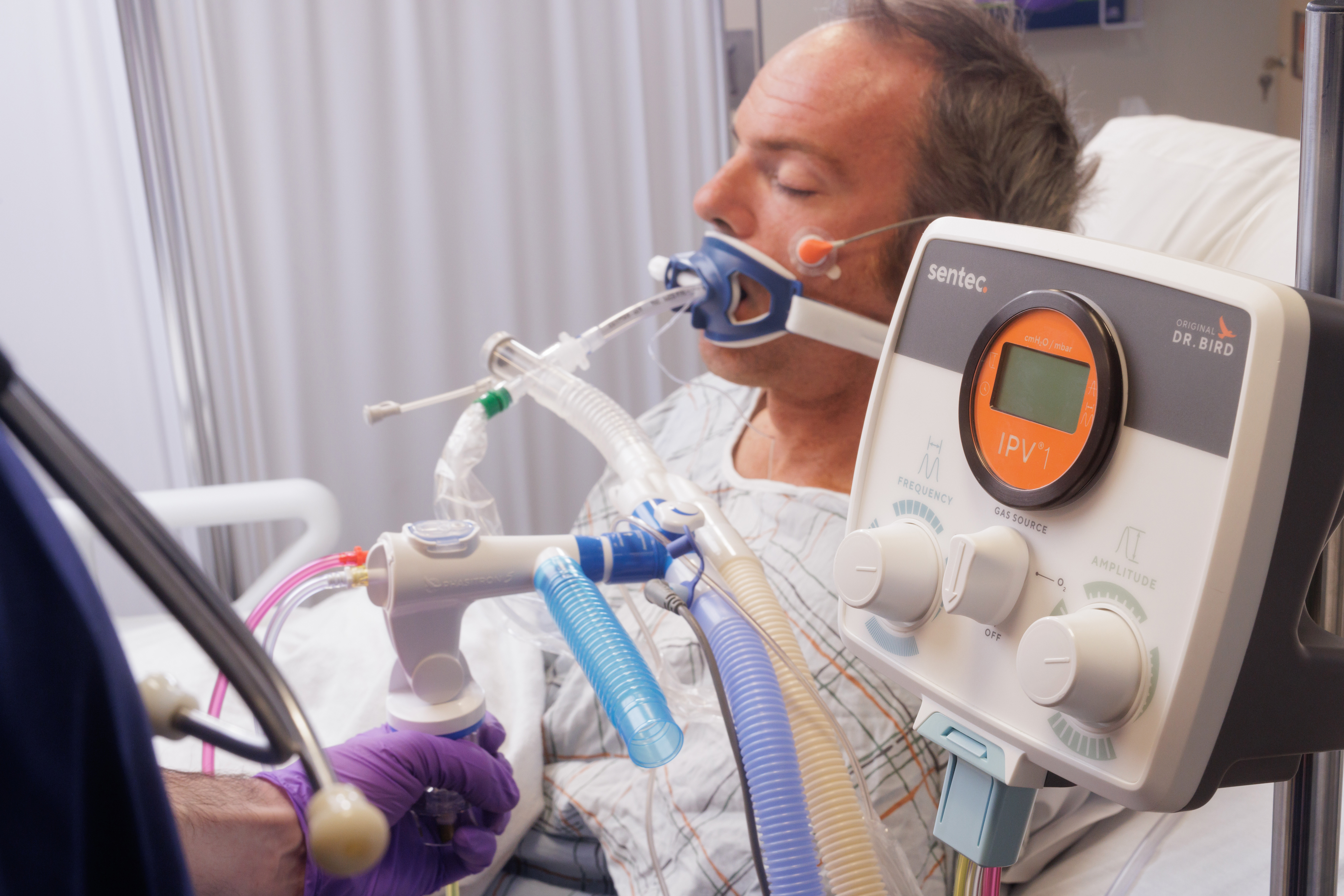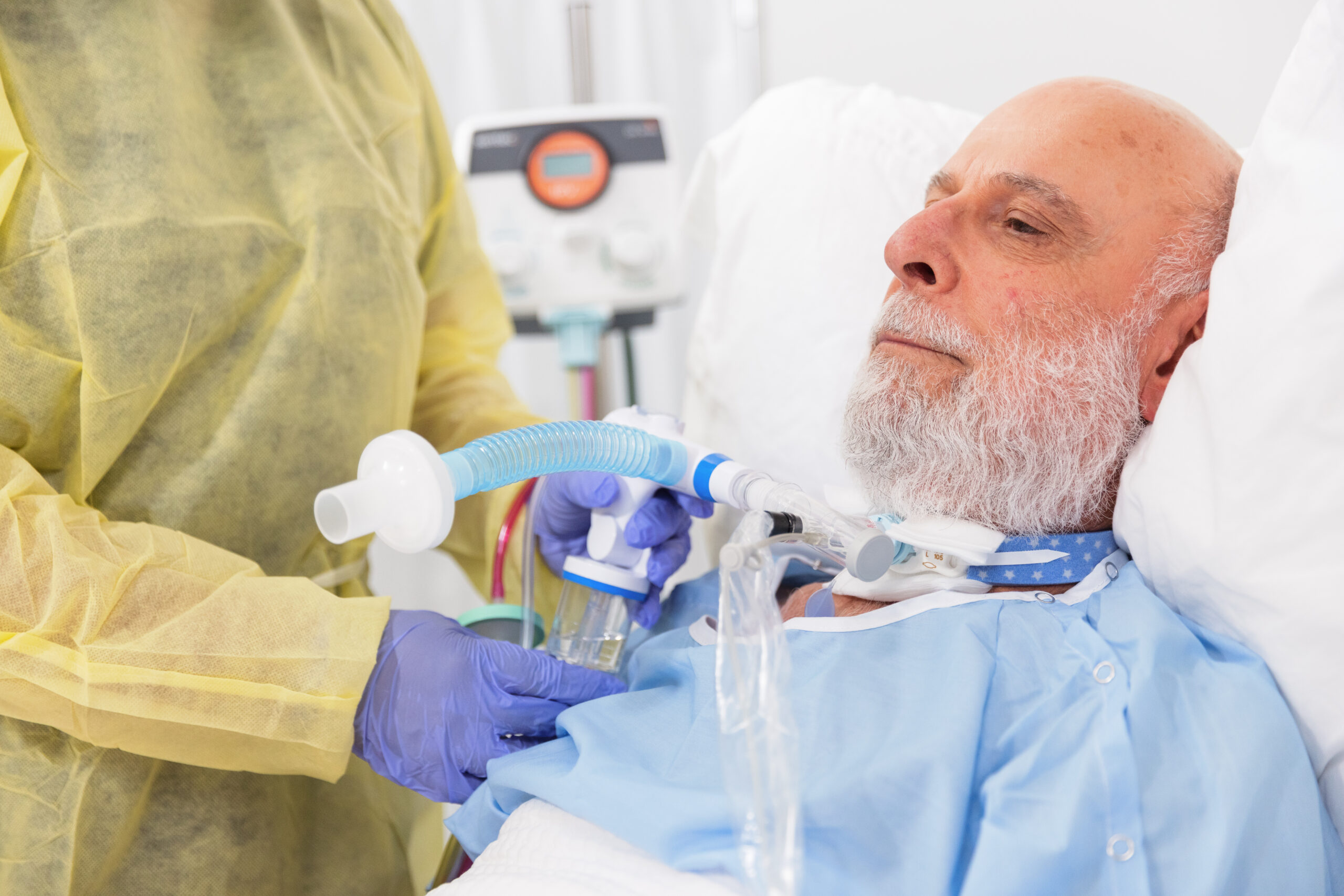By Crystal Sinclair, BS, RRT-NPS
Intrapulmonary percussive ventilation (IPV) therapy is an airway clearance therapy that combines percussion, high-velocity flow, and entrainment to mobilize secretions and address gas exchange impairment. The therapy can be delivered through a mouthpiece or mask, directly to the airway, or in-line with a ventilator, making it versatile for a range of patient populations. One of the significant advantages of IPV therapy is its ability to recruit distal airways in the lungs, a notoriously difficult-to-reach area. By effectively accessing these regions, IPV therapy can support improvements in gas exchange capacity – and may even outperform other airway clearance techniques.¹
In addition to its clinical benefits, IPV therapy offers versatility across care settings, extending its applicability to hospitals, long-term care facilities, and even home care.
What problems can IPV therapy address?
For individuals with chronic respiratory conditions, or who are experiencing acute gas exchange impairment, maintaining clear airways is essential for optimal lung function. Gas exchange, which involves the transfer of oxygen and carbon dioxide to and from the bloodstream, is often compromised in respiratory patients due to a variety of factors, including secretions, weak cough, inflammation, and infection. From these factors, three primary symptoms stand out for their roles in compromising a patient’s gas exchange capacity: secretion retention, air trapping/hyperinflation, and atelectasis/derecruitment.
Secretion retention, and the often-resulting mucus plugs, are a major cause of lung function impairment that can negatively affect gas exchange. This can be the result of a weak or ineffective cough, which can be due to post-surgery pain, infection, trauma, or from pulmonary muscle weakness as seen in neuromuscular disorders. In these cases, the buildup of secretions and mucus plugs can restrict gas exchange by blocking or narrowing the airways, or simply by creating a physical barrier between the air in the lungs and the surface of the airway.
Problematic on their own, secretion retention and mucus plugs may also lead to two major respiratory complications: atelectasis and hyperinflation, which can have a further negative impact on gas exchange. Atelectasis refers to a partial or complete collapse of the lungs, resulting in reduced surface area available for gas exchange. Hyperinflation, on the other hand, occurs when the lungs become overinflated, limiting their ability to effectively exchange gases.
Impaired gas exchange capacity has several consequences. On one hand, the reduced oxygenation of the blood, or hypoxemia, leads to decreased oxygen supply to the body’s tissues and organs, resulting in symptoms that can include shortness of breath and wheezing. Secondly, the accumulation of excess carbon dioxide in the bloodstream, known as hypercapnia, may lead to confusion, drowsiness, and in some cases, respiratory failure. Because of the negative outcomes that can result, addressing gas exchange capacity impairment through airway clearance techniques is often a critical aspect of care for respiratory patients. In these cases, IPV therapy may serve as a valuable tool.
How IPV therapy works
IPV therapy devices operate by delivering a continuous, percussive flow through a mouthpiece, mask, direct to the airway, or in-line with a ventilator. IPV therapy benefits patients by working to address the triad of separate but often interconnected complications that each impair gas exchange capacity in their own way: secretion retention, air trapping/hyperinflation, and atelectasis/derecruitment.
The clinical impact of IPV therapy arises from its distinct mechanism of action. Central to the success of IPV therapy is the Phasitron , an innovative component of IPV therapy devices that plays a pivotal role in enhancing both the therapy’s safety and its effectiveness. Within the Phasitron is the sliding venturi, a small mechanism that moves back and forth as the therapy is being delivered. This movement enables three flow characteristics that work to restore the patient’s available capacity for gas exchange: percussion, high-velocity flow, and entrainment.
During treatment, the IPV therapy device administers percussions that are further enhanced by the sliding venturi, which work to loosen secretions and break up mucus plugs within the airways. The high-velocity flow enables the treatment to access distal airways, moving beyond obstructions and mobilizing secretions away from the airway walls. This dynamic airflow also facilitates an expiratory flow that supports the outward movement of secretions, working to address both blockages within the airway and the hyperinflation or atelectasis that may result.
At the same time, IPV therapy entrains air, which plays a pivotal role in lung recruitment and addressing potential atelectasis. This process also enables a dynamic response to lung resistance and compliance, offering a treatment experience that is finely tuned to the specific condition of each patient. As the percussions, high-velocity flow, and entrainment work together, the airway may be effectively cleared, recruited, and relieved of air trapping, resulting in a greater portion of the lung being available to perform gas exchange.
The strength and frequency of the percussions delivered with IPV therapy can be adjusted based on the individual patient’s needs and response to therapy: higher (faster) frequencies are often recommended for thinner secretions and general mobilizations, while lower (slower) frequencies may be appropriate for thicker secretions/mucus plugs and an enhanced recruitment effect. Healthcare professionals typically determine the appropriate settings using their clinical judgment based on factors such as the patient’s condition, lung function, tolerance, and comfort.
Who can benefit from IPV therapy?
Dynamically responding to patient lung conditions, IPV therapy has the potential to effectively treat a wide range of respiratory patients facing gas exchange capacity limitations. Moreover, the therapy can be adjusted regarding intensity, frequency, and treatment interval and/or duration according to patient need, expanding the versatility of IPV therapy. There is clinical evidence of the safety and effectiveness of IPV therapy in a diverse range of patient populations and conditions, including:
- Patients on mechanical ventilation2
- Patients on noninvasive ventilation (NIV)
- Patients with an artificial airway
- Tracheostomized patients3
- Pediatric patients
- Neonatal patients
- Bronchiolitis patients4
Other patient populations
Beyond its broad use across individuals in need of airway clearance therapy, IPV therapy has shown to be clinically safe and effective across specific patient populations, including COPD, neuromuscular diseases, and CF.
Chronic Obstructive Pulmonary Disease (COPD)
IPV therapy has demonstrated positive results in managing patients with COPD, a progressive respiratory condition that affects more than 15 million adults in the United States alone.5 Notably, one clinical trial found that IPV therapy may be as safe and effective as standard chest physical therapy for patients with COPD, with IPV offering a distinct advantage of providing a more comfortable airway clearance option for these individuals.6
Neuromuscular Diseases
Those with neuromuscular diseases, such as Duchenne muscular dystrophy (DMD) and amyotrophic lateral sclerosis (ALS), often experience respiratory muscle weakness, resulting in a weak or ineffective cough. This not only compromises ventilation but also heightens the susceptibility to respiratory complications, including secretion retention and infections. In these cases, research indicates that incorporating IPV therapy can prove beneficial. One study found that the use of IPV therapy in children with neuromuscular diseases was associated with fewer occurrences of respiratory infections.7
Cystic Fibrosis (CF)
For individuals with cystic fibrosis (CF), excessive mucus causes airway obstruction, inflammation, and increased vulnerability to infections, resulting in potential lung damage and impaired gas exchange capacity. To address these challenges, daily bronchopulmonary hygiene therapy is an essential aspect of CF care. IPV therapy has shown to be a viable therapy option supported by clinical evidence, offering effective airway clearance for this patient population.8
Sentec IPV Therapy
See the impact of IPV therapy on respiratory care with Sentec IPV Therapy – the trusted solution for secretion clearance, hyperinflation relief, and lung recruitment. Designed to enhance gas exchange capacity for diverse patient populations, Sentec IPV Therapy incorporates percussion, high-velocity flow, and entertainment, while leveraging the uniquely effective Phasitron to offer a dynamic treatment. Sentec offers a range of IPV devices with customizable settings, allowing healthcare providers to optimize the utilization of IPV therapy to best support their patients.
How can Sentec IPV Therapy make a difference for your patients?
IPV therapy is safe and well-tolerated across diverse patient populations, care settings and delivery interfaces. Explore our clinical impact summary, where we examine the evidence that support IPV therapy as an effective treatment option for a wide range of use cases and patient groups.
To download the summary, please fill out the form below:
References:
- Nicolini, A., et al. Safety and effectiveness of the high-frequency chest wall oscillation vs intrapulmonary percussive ventilation in patients with severe COPD. Int J Chron Obstruct Pulmon Dis. 2018.
- Conomon, D., et al. High frequency percussive airway clearance utilizing two devices in simulation of mucous clearance, without spontaneous breathing, both with and without mechanical ventilation. Respir Care. 2021.
- Clini, E.M., et al. Intrapulmonary percussive ventilation in tracheostomized patients: a randomized controlled trial. Intensive Care Med. 2006.
- Cavari, Y., et al. Intrapulmonary percussive ventilation for children with bronchiolitis on non-Invasive Ventilation support. Open J Pediatr Child Health. 2022.
- COPD. National Heart, Lung, and Blood Institute. Updated March 24, 2022. Accessed May 26, 2023. https://www.nhlbi.nih.gov/health/copd.
- Testa, A., et al. Efficacy of short-term intrapulmonary percussive ventilation in patients with chronic obstructive pulmonary disease. Disabil Rehabil. 2015.
- Reardon, C.C., et al. Intrapulmonary percussive ventilation vs incentive spirometry for children with neuromuscular disease. Arch Pediatr Adolesc Med. 2005.
- Varekojis, S.M., et al. A comparison of the therapeutic effectiveness of and preference for postural drainage and percussion, intrapulmonary percussive ventilation, and high-frequency chest wall compression in hospitalized cystic fibrosis patients. Respir Care. 2003.





